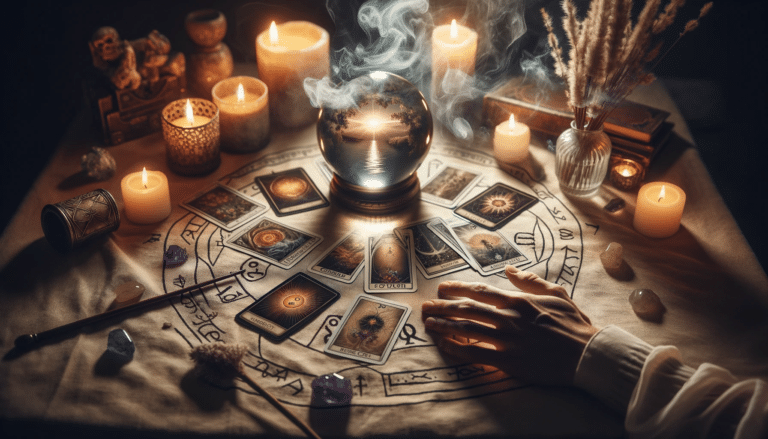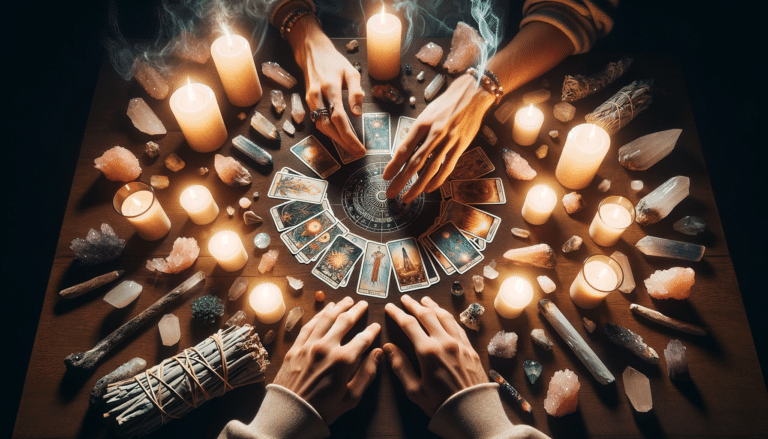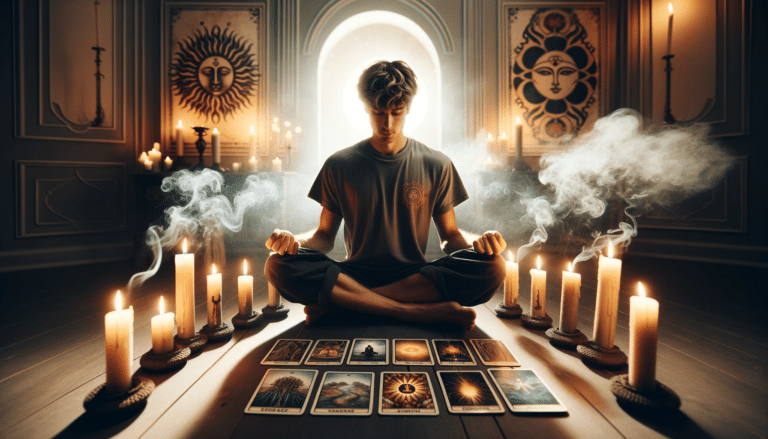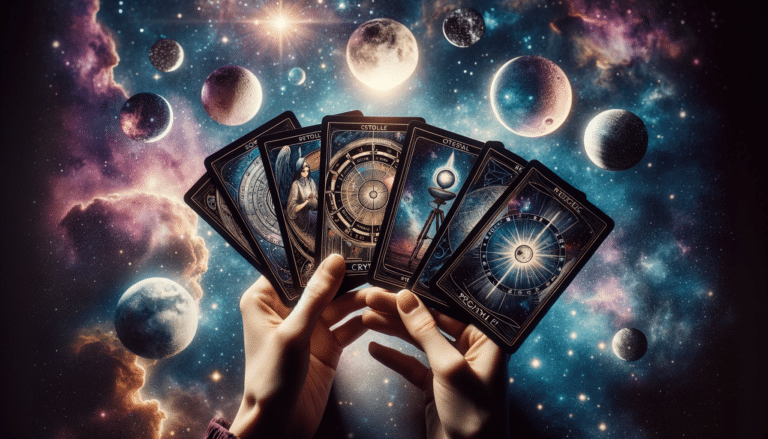Understanding Tarot Card Colors And Symbols – What Do They Mean?

Did you know most tarot enthusiasts struggle to understand card colors and symbols?
So, let’s demystify this together.
In this guide on understanding tarot card colors and symbols, you’ll discover the significance of colors and symbols in tarot cards. We’ll delve into the meanings behind vibrant reds, soothing blues, and even the stark contrast of black and white. By the end, you’ll be interpreting complex tarot symbols with ease.
Welcome to the fascinating world of tarot interpretation. Let’s get started!
Key Takeaways
- Colors in tarot cards, such as red, blue, green, and yellow, hold specific meanings that influence the overall interpretation of the cards.
- Symbols in tarot cards, like cups, swords, wands, and pentacles, also carry significant meanings related to elements and aspects of life.
- Understanding the meanings of colors and symbols can provide a deeper and richer reading experience in tarot card interpretations.
- Context plays a crucial role in interpreting both colors and symbols in tarot cards, and using color interpretation guides can provide profound insights.
The Basics of Tarot Card Colors
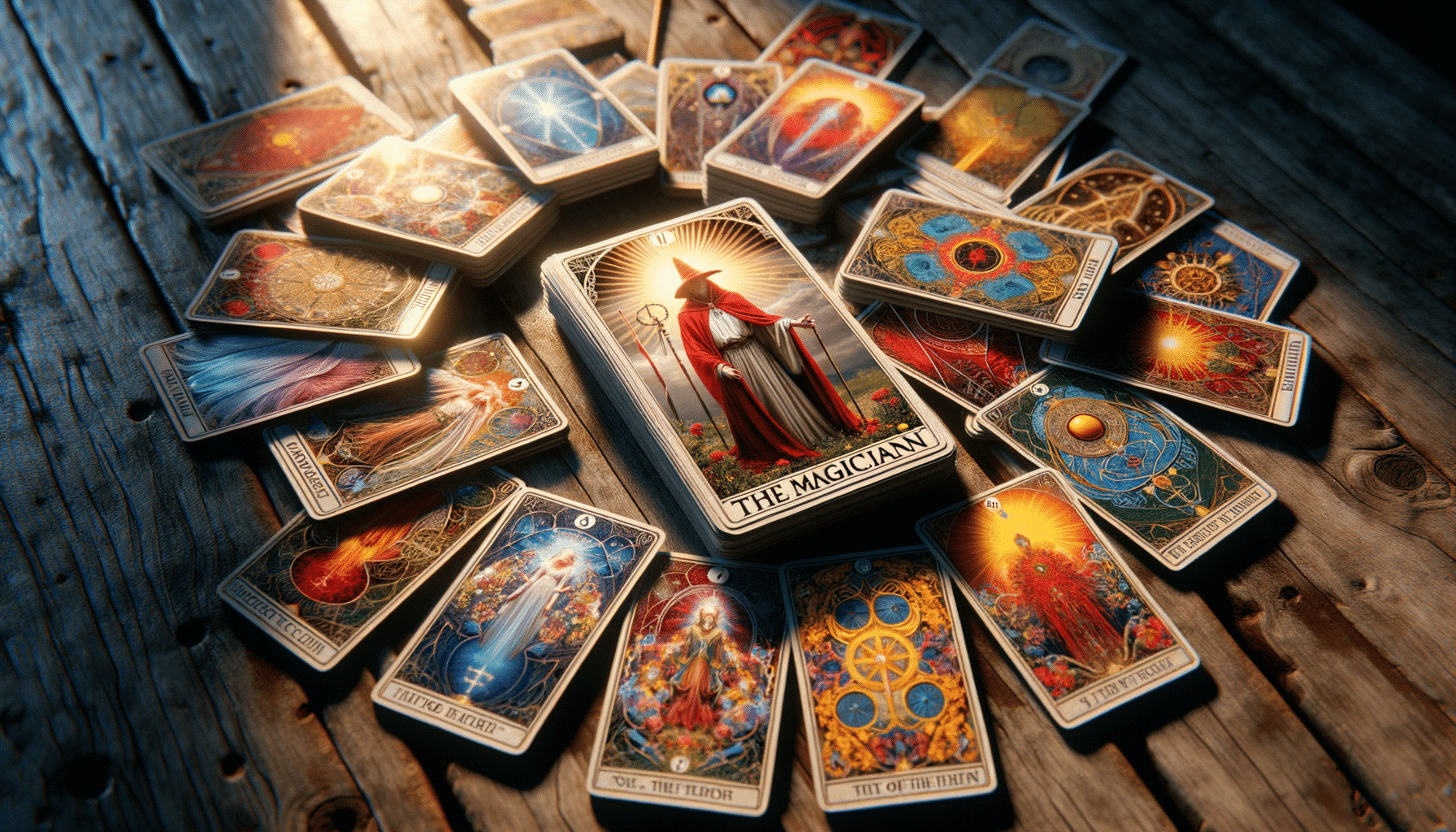
In your journey through the realm of Tarot, understanding the basic symbolism of card colors is key to gaining deeper insights. Each color holds a specific meaning that influences the overall interpretation of the card. Let’s delve into this.
Red, for instance, symbolizes passion, action, and physical energy. It’s the color of the fire element, representing motivation and desire. If you pull a card dominated by red, it might mean you’re being called to take action.
Blue, on the other hand, signifies emotions, intuition, and spiritual guidance. It’s linked to the water element, reflecting depth, calmness, and healing. A blue-dominant card could indicate you need to trust your feelings or intuition.
Green is associated with nature, fertility, and growth. This earthy color could signify a period of development or stability in your life.
Yellow, tied to the air element, symbolizes intellect, creativity, and communication. A yellow-heavy card might point to an incoming message or a burst of new ideas.
Check out our Tarot Cards here…
Deciphering Tarot Symbols

Now, let’s turn our attention to the symbols on tarot cards.
You’ll uncover the meanings of common symbols and learn how color can change their interpretation.
Knowing what these symbols signify can deepen your understanding of tarot readings.
Understanding Common Symbols
With tarot cards, you’ll often encounter recurring symbols that hold significant meanings.
These symbols are crucial in understanding the message the universe is trying to convey. For instance, the presence of cups, which represents water, implies emotions, intuition, and relationships. Swords symbolize air, indicating thoughts, communication, or conflict. Seeing a wand, representing fire, signifies action, passion, or creativity, while pentacles, symbolizing earth, point to material aspects like work, money, or practical skills.
Animals also bear symbolic weight. Lions signify courage and strength. Birds often symbolize freedom or spiritual messages. Understanding these symbols will enhance your tarot readings and offer deeper insights.
Don’t be discouraged if it seems complex. With practice, you’ll become proficient in deciphering these mystical symbols.
Interpreting Color Significance
Just as symbols play a crucial role in tarot, colors also carry their own unique meanings that you’ll need to understand. They add another layer of interpretation, enhancing your ability to decipher the cards’ messages.
Here’s a quick guide:
1. Blue often represents wisdom, truth, and intuition.
2. Green is typically linked to growth, abundance, and healing.
3. Yellow can suggest intellect, creativity, and energy.
4. Black may symbolize mystery, the unknown, and sometimes, negativity.
Understanding these color significances can give you a richer, deeper reading. Remember, however, that meanings can vary depending on the deck and the specific imagery used. It’s all about context.
Now, let’s delve deeper into a specific color and discover the significance of red in tarot.
Learn about more Basics of Learning Tarot here…
Significance of Red in Tarot

In Tarot, red often symbolizes passion, energy, and action. This vibrant color captures the essence of life force, and ignites a spark of vitality and dynamism. When a card with a significant amount of red appears in your reading, it’s telling you to pay attention to your primal instincts and urges. Are you channeling your energy towards your dreams, or are you allowing it to consume you, leading to anger or aggression?
Red also represents the element of fire. So, if you’re seeing a lot of red in your readings, it might indicate a fiery nature, determination, or even a heated situation. It’s a call to harness your inner power, to be bold and take charge. Yet, it’s also a warning to control these fiery emotions, to prevent them from causing havoc.
Remember, color interpretations can vary based on the context and the individual card’s symbolism. Thus, it’s essential to consider the overall picture that the Tarot spread presents.
Now that we’ve explored the significance of red, let’s dive into the calming, soothing world of blue in Tarot cards.
Learn even more secrets of Tarot Card Interpretation here…
Meaning of Blue in Tarot Cards

Now, let’s delve into the symbolism of the color blue in Tarot cards, a stark contrast to the fiery red we just discussed. Unlike red’s passionate energy, blue tends to embody tranquillity, wisdom, and the spiritual realm. It’s a serene color, often associated with depth and stability.
-
Calmness and Serenity: Blue’s soothing nature promotes relaxation and harmony. When it appears in your Tarot reading, it may be a signal to slow down and nurture peace within yourself.
-
Intuition and Spirituality: Blue also represents the spiritual and the subconscious. It’s an invitation to develop your intuition and connect with your higher self.
-
Wisdom and Knowledge: This cool color signifies wisdom and knowledge. It suggests a time for introspection and learning. Seeing a lot of blue may be a cue to seek wisdom and truth.
-
Healing and Health: Lastly, blue is often linked to healing and health. It may indicate a period of healing or the need to pay attention to your physical well-being.
The Role of Green in Tarot

Let’s shift our focus to the significant role of green in Tarot, a color that typically symbolizes growth, renewal, and the natural world. When you see green in your Tarot reading, it’s a sign of flourishing energy. It could mean you’re about to experience personal growth or there’s a need to connect more deeply with nature.
Green also represents healing. It’s the color of the heart chakra, which is linked to love, compassion, and emotional well-being. If green appears prominently, it might be a nudge to nurture your emotional health or to foster more love and compassion in your life.
Beyond these, green symbolizes prosperity and abundance. It suggests that financial gains or other forms of success are likely. Don’t be surprised if you see a green card when asking about career or money matters!
Understanding Black and White in Tarot

You’ll find a stark contrast when you come across black and white in your Tarot readings, each color carrying its own meaningful symbolism.
Black, often associated with mystery, the unknown, and the subconscious, can signify something that’s hidden or yet to be revealed, while white, linked with purity, clarity, and truth, can point to new beginnings or spiritual enlightenment.
Now, let’s dive deeper into the meanings of these two colors:
-
Black: This color often appears in cards associated with deep introspection, such as The High Priestess or The Hermit. It encourages you to seek answers within, to face your shadow self, and to embrace the unknown.
-
White: Usually found in cards like The Fool or The Sun. It symbolizes innocence, purity, and enlightenment. You’re nudged to embrace positivity, openness, and clarity.
-
Black and White Together: Their presence in the same card, like in The Moon, indicates a balance, a meeting of the conscious and unconscious, reminding you that life isn’t just black or white.
-
Absence of Color: If neither color is predominant, it could signify a need for balance or neutrality.
Interpreting Complex Tarot Symbols

Many complex symbols can show up in your Tarot readings, each carrying a unique interpretation that’s essential to understand. These symbols, often steeped in historical and cultural contexts, can add layers of meaning to your readings, providing a richer narrative.
To help you navigate these intricate symbols, here’s a useful table:
| Symbol | Interpretation |
|---|---|
| Angel | Messages from the divine, spiritual guidance, higher consciousness |
| Ankh | Life and immortality, life-giving power, spiritual awakening |
| Arch | Transitions, gateways, protection, support |
| Bench | Rest, contemplation, stability, pause |
| Bird | Freedom, perspective, communication, spiritual insights |
| Blindfold | Lack of vision or clarity, impartiality, intuition |
| Butterfly | Transformation, change, rebirth, soul, personal growth |
| Caduceus | Healing, negotiation, balance, duality |
| Water | Emotions, intuition, subconscious, flow of life |
| Mountains | Challenges, obstacles, spiritual aspirations |
| Stars | Hope, inspiration, spirituality, divine guidance |
| Clouds | Mystery, uncertainty, divine intervention |
| Sun | Vitality, enlightenment, positivity, life energy |
| Moon | Subconscious, illusions, intuition, femininity |
| Flowers | Growth, beauty, unfolding of spiritual or emotional processes |
| Garden | Conscious mind, safety, security, personal environment |
| Sword | Intellect, communication, truth, challenges, conflict |
| Wand | Creativity, action, ambition, personal power |
| Pentacle | Material aspects, wealth, work, physical health |
| Cup | Emotions, relationships, connections |
| Lion | Strength, courage, passion, aggression |
| Castle | Safety, security, personal power, goals |
| Crown | Authority, self-mastery, recognition |
| Snake | Transformation, healing, rebirth, danger |
| Tree | Growth, connection to life, stability, strength |
| Boat | Journeys, transitions, moving through phases |
| Path | Life’s journey, destiny, choices, progress |
| Dog | Loyalty, faithfulness, protection, instinctual nature |
The above table of symbols found in the tarot cards is by no means complete and exhaustive, but it’s a good start to get you going in the right direction.
Practical Tips for Interpreting Colors and Symbols
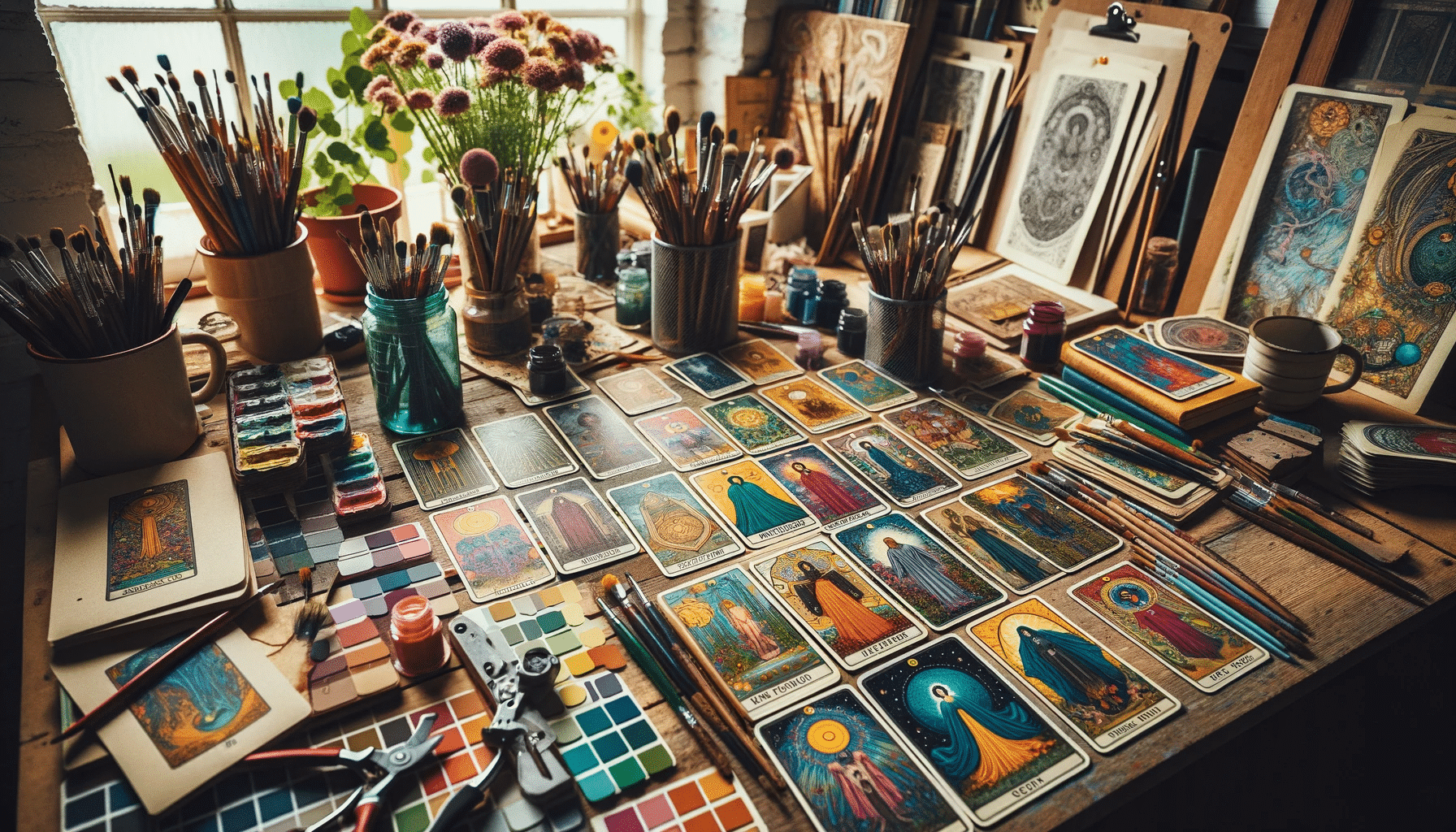
Now, let’s move on to some practical tips for interpreting tarot card colors and symbols.
You’ll find a color interpretation guide helpful, as each hue can carry significant meanings.
Understanding symbol meanings is essential too, as they provide deeper insights into your tarot readings.
Color Interpretation Guide
Understanding the nuanced language of color in tarot cards can offer you profound insights during your readings. Each color holds a unique energy and message, which can significantly influence the interpretation of a card.
This guide on understanding tarot card colors and symbols has given you the basic meanings, but context and intuition also play a crucial role in your readings.
Remember, tarot interpretation isn’t always straightforward.
Incorporating color meanings into your tarot readings can deepen your understanding and enhance your intuitive skills.
Now, let’s delve deeper into understanding symbol meanings in tarot cards.
Understanding Symbol Meanings
Frequently, you’ll find that interpreting symbols in tarot cards can be as enlightening as understanding the colors. Each symbol carries a distinct message that contributes to the overall meaning of the card.
So, let’s get to it…
Start by looking at the symbols objectively, don’t rush into conclusions. Each symbol, like a wand or a pentacle, carries a fundamental meaning. Wands often represent action or creativity while pentacles might symbolize material wealth or physical aspects.
Yet, context is key. A wand in a positive position may suggest a burst of energy or a new project. But, in a negative position, it could mean misdirected energy or delays.
Dive deep into the details, and you’ll unravel the mystery of tarot symbols.
Frequently Asked Questions About Understanding Tarot Card Colors and Symbols

How Can I Incorporate My Personal Interpretations Into Reading Tarot Cards?
You can incorporate personal interpretations into tarot reading by trusting your instincts. Don’t worry about traditional meanings. Focus on what the cards’ images and colors suggest to you. They’re tools to unlock your intuition.
What Is the Historical Background of Tarot Card Colors and Symbols?
Peeling back the layers of history, you’ll uncover that tarot card colors and symbols stem from various cultures and eras. They’re not just random, they carry deep, historically-rooted meanings that enrich your tarot reading experience.
How Does the Color or Symbol of a Tarot Card Change Its Meaning in Different Card Spreads?
You’re asking how colors or symbols on tarot cards can alter their meanings in various spreads. Well, the card’s placement can change its interpretation, as colors and symbols gain different contexts in each position.
Do the Meanings of Tarot Card Colors and Symbols Differ Among Different Cultures?
Yes, tarot card colors and symbols can hold different meanings across cultures. They’re like universal languages with dialects. Each culture interprets them based on their unique beliefs, customs, and historical contexts. It’s fascinating, isn’t it?
Can the Same Tarot Card Color or Symbol Have Conflicting Meanings?
Yes, the same tarot card color or symbol can have conflicting meanings. It’s all about interpretation. You’ve to consider the card’s position, the question asked, and your personal connections to the symbol.
Conclusion
So, you’ve taken a deep dive into the vibrant world of tarot cards, unmasking the meaning behind colors and symbols. Remember, like a rainbow after a storm, the cards are filled with layered meanings.
Don’t fret if it feels overwhelming. With patience and practice, you’ll soon be interpreting these mystical colors and symbols like a pro. So, keep your deck close and your mind open.
Your tarot journey has just begun.
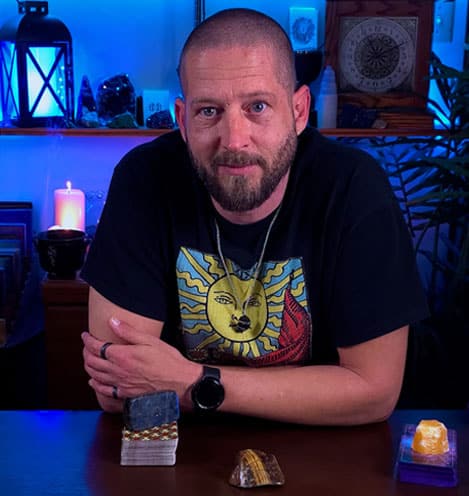
About The Author – Allen Hill
Allen Hill, the force behind Unknown Truth Tarot, has a YouTube following 6-times bigger than the population of his hometown, Miamisburg, Ohio. From his spiritually rich blog on Tarot and crystals to his role as CEO of The Unknown Truth Tarot Metaphysical Shop, Allen’s passion for the metaphysical shines through.
A master Tarot reader and “crystal junkie,” Allen is also a devoted dad to Dylan, 10, and Destiny, 24. When he’s not immersed in the world of Tarot and crystals, he enjoys poker and video gaming sessions, often humorously outplayed by Dylan.
Follow Allen on Twitter, Instagram, Facebook, TikTok, and subscribe to his Unknown Truth Tarot YouTube channel to join him on a journey of spiritual growth and self-discovery.

